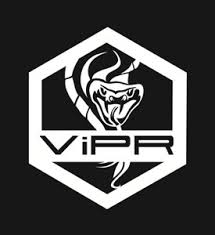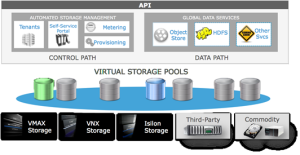“The one who follows the crowd will usually go no further than the crowd, the one who walks alone is likely to find themselves in places no one has ever been before”
With EMC world running this week in Las-Vegas and another raft of announcements made, I thought I’d post a blog on the new technology and more importantly the terminology which is currently in the market place. It seems the market is full of software defined messages at the moment, and this is a good thing. It means that as end users we have choice of what platform/model we adopt and use, but too many choices can be over whelming.
You may have seen that last year at EMC world EMC announced ViPR the software defined data centre message. Over the last 12 months ViPR is making traction in the market place. But lets take a step back and think what is ViPR’s aim? In my view it is to automate and do what we do today only better, the whole point of having something defined/automated in software is to improve what we do today and automate where we can. One person once summed up SDDC for me pretty well, and simply stated “Software Defined is simply doing for the data centre what Virtualisation did for the server layer”. The concept to understand with ViPR is that its application centric which means the storage services are aligned to the applications.
ViPR has just recently had support extended to HDS as well as NetApp, which is a great in road for the industry as it is the only product currently aimed at this space and trying to abstract, automate and pool resources. If you are interested in ViPR go to http://www.emc.com and download the trial which is a great insight in what this product achieves.
Okay so we have discussed one element of SDDC but this is only the storage layer, what about hardware what do I run this software on? Personally I don’t think the industry is too far away from having standardised appliances which run specialised software for your feature/functions. The server industry is now pretty much X86 and we will not be far from “Commodity” in the coming years for compute, network and storage. This means as a customer you can purchase “White box” hardware and build the software stack on this yourself such as Open Stack and a virtualisation engine or you can buy an appliance which comes already built.
EMC just announced EMC ECS (Elastic Storage Compute) EMC ECS which is exactly the latter of the paragraph above. This was previously known as “Project Nile” and is a hyper scale cloud solution which promises lower TCO costs than moving to a public cloud but being a private cloud solution is more secure. Now let me do some jargon busting here, the EMC ECS is designed for what EMC dub the “3rd Platform” this is the mobile, social and big data platform where we are managing/running millions of diverse applications rather than the traditional server client model and traditional applications.
What is a great story with ECS is the fact it can be converged with existing Private or hybrid cloud models and will boast a whole host of features from automated provisioning, self-service & 28% lower TCO than Google or Amazon. These are bold statements but I believe this is genuinely pioneering. Lets think about what I said before putting advanced software on to commodity hardware, thats all ECS is, its EMC ViPR & SRM running on standardised servers, network and storage providing seamless application provisioning and huge scale (up to 2.9PB). This is clearly aimed at service providers or companies who are considering a hybrid cloud model as a lower TCO for an environment, in my experience this year the word “Hybrid Cloud” is on everyone’s mind and is starting to ring home with companies as budgets and staff become ever more stringent.
On we go to another option or choice, do I simply employ a hybrid cloud model and off load some of my workloads to a lower TCO option in the cloud and let someone else look after it? In this space again there are an abundance of providers, newest to the market being VMware VCHS, or do I simply go to a full public model?
Another choice is do I go converged and buy everything as an appliance on specialised Hardware? Nearly every vendor in the market place now offers something like a VBLOCK.
I think you are beginning to get the idea, the market is full of choice now and choices that need to be carefully considered. If we get too lost in cost and functionality then we may lose sight of what it is we require from SDDC which is simplicity, scalability and speed of provisioning. As IT departments move to a DEV OPS environment more and more technical functionality speciality will be lost to service delivery and management, and this change is being forced by the nature of the world we live in today. Everything must be faster, more efficient and simple, managing large complex multi vendor infrastructures will start to become cumbersome and too costly. I think what is unique here is EMC have acknowledged the “Cloud” from an early stage and can now offer you a fully built cloud solution or a build it yourself option such as ViPR and your choice of commodity HW & Open Stack or something similar.
The last and final choice is, “When do I choose a direction?” This is a difficult choice the market now is full of options for all services “Cloud” and these services are ever evolving. Look how far ViPR has come from one year ago being a piece of software dipping its toe in the environment to now where it is fully embedded in an appliance and offered as “Cloud in a box”. What I would say or advise on this subject is look at where you are now and the plans of the business. This eludes to what I stated earlier, “what is the businesses primary function?” lets take a car manufacturer their sole purpose is to manufacture and sell a car for the greatest % of profit and gain as much market share as possible. If the business has stated they need to be smarter or more efficient to keep up with competitors then the business starts to look at gains/improvements which can be made across the board, lets not forget IT is a supportive function of the business.
I have worked with many customers who have a whole raft of solutions they have either tried & tested, are looking at or have heard of. My advice would be look at where you are now and the coming 3 years and assess what you can do. EMC Adaptivity can look at what applications your business uses which are suitable for certain cloud platforms, private, public or hybrid and classify what cost savings & efficiencies you can expect to gain. This is a great tool as every IT professional I have met has stated to me “I am unsure whether that application could exist in the cloud” and as we all know application landscapes are large & complex.
Once you know where you are it is easier to then make a decision on the best solution going forwards which will lets face it come down to end user experience, this is such a huge factor that many overlook. My final thought on this is EMC are daring to be a little different especially with products like ECS, ViPR and Scale IO, they are changing as a company and are always on top of the curve. With that in mind, EMC one of the largest hardware vendors in the world has admitted “Times they are a changing” and have adapted to the new demands in the market place, as end users we should adopt and try these new technologies as without trying we will not be any different from competitors or gain any new benefits.



